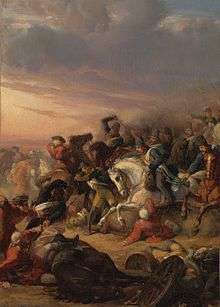Battle of Castricum
| Battle of Castricum | |||||||
|---|---|---|---|---|---|---|---|
| Part of the Anglo-Russian Invasion of Holland | |||||||
 Anno 1799, De slag bij Castricum by Jan Antoon Neuhuys (Amsterdam Museum) | |||||||
| |||||||
| Belligerents | |||||||
|
|
| ||||||
| Commanders and leaders | |||||||
|
|
| ||||||
| Strength | |||||||
| 25,700 | 26,400 | ||||||
| Casualties and losses | |||||||
| 1,382 |
2,536 men 11 guns | ||||||
The Battle of Castricum (October 6, 1799) saw a Franco-Dutch force defeat an Anglo-Russian force near Castricum, Netherlands. The battle was fought during the War of the Second Coalition against Revolutionary France between French and Dutch forces under the command of General Guillaume Brune and Herman Willem Daendels and British and Russian forces under the command of the Duke of York, Sir Ralph Abercromby and the Prince of Orange.
Background
An Anglo-Russian force of 32,000 men landed in North Holland on August 27, 1799, captured the Dutch fleet at Den Helder on August 30 and the city of Alkmaar on October 3. Following a series of battles at Bergen on September 19 and Alkmaar on October 2 (also known as 2nd Bergen), they faced the French and Dutch armies at Castricum on October 6.
Action
The town of Castricum passed from British-Russian to Batavian-French hands several times until the former finally fled, losing 2536 men and 11 guns; the Batavian-French losses stood at 1382. The defeat persuaded the Duke that his position was untenable. After a chaotic retreat, the parties signed the Convention of Alkmaar on October 10.
Aftermath
The British and Russians were allowed to withdraw, without paying reparations, and retaining captured bounty. As a sign of gratitude for enabling him honourably to emerge from the inglorious Dutch imbroglio, Brune received a number of horses from the Duke. By 19 November all the British and Russian troops had been embarked and the expedition was over. In the years following the 1799 invasion, defensive lines were constructed in Holland to protect Amsterdam from future invasions from the north.
Commemoration
In the Huis met de Kogel (House with the Cannonball) in Castricum, a cannonball that got stuck in the wall during the battle can still be seen. A plaque beneath the cannonball commemorates the battle.[1] Various locality names in Castricum also provide a reminder of the battle, like the Russenbergen dunes and the Doodelaan street. The Russisch Monument in Bergen marks the fighting there. The French victory was also commemorated on the Arc de Triomphe in Paris as "Alkmaer".
References
- ↑ "Genealogie.algemeen00.html". kazenbroot.nl.
External links
- Anglo-Russian invasion of North Holland (1799)
- Noord-Holland 1799 (in Dutch)
- De Engels-Russische inval (in Dutch)
Coordinates: 52°33′00″N 4°40′00″E / 52.5500°N 4.6667°E